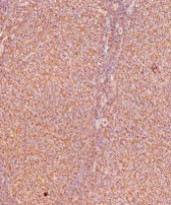ARG67040
anti-MHC class I antibody [SQab30331]
anti-MHC class I antibody [SQab30331] for IHC-Formalin-fixed paraffin-embedded sections,Western blot and Human

1
Overview
| Product Description | Recombinant rabbit Monoclonal antibody [SQab30331] recognizes HLA |
|---|---|
| Tested Reactivity | Hu |
| Tested Application | IHC-P, WB |
| Host | Rabbit |
| Clonality | Monoclonal |
| Clone | SQab30331 |
| Isotype | IgG |
| Target Name | HLA |
| Antigen Species | Human |
| Immunogen | Recombinant protein of Human MHC class I. |
| Conjugation | Un-conjugated |
| Protein Full Name | HLA class I histocompatibility antigen |
| Alternate Names | HLA-A, Major Histocompatibility Complex, Class I, A, HLA Class I Histocompatibility Antigen, A Alpha Chain, HLAA, HLA Class I Histocompatibility Antigen, A-1 Alpha Chain, MHC Class I Antigen HLA-A Heavy Chain, Leukocyte Antigen Class I-A, Human Leukocyte Antigen A, HLA-B 2, Major Histocompatibility Complex, Class I, B, HLA Class I Histocompatibility Antigen, B Alpha Chain, HLAB, AS, MHC Class I Antigen HLA-B Alpha Chain, MHC Class I Antigen HLA-B Heavy Chain , MHC HLA-B Transmembrane Glycoprotein, MHC HLA-B Cell Surface Glycoprotein, HLA-C, Major Histocompatibility Complex, Class I, C, HLA Class I Histocompatibility Antigen, C Alpha Chain, HLA-JY3, D6S204, PSORS1, HLAC |
Application Instructions
| Application Suggestion |
|
||||||
|---|---|---|---|---|---|---|---|
| Application Note | The dilutions indicate recommended starting dilutions and the optimal dilutions or concentrations should be determined by the scientist. | ||||||
| Positive Control | Tonsil | ||||||
| Observed Size | 40 - 50 kDa |
Properties
| Form | Liquid |
|---|---|
| Purification | Purification with Protein A. |
| Buffer | PBS, 0.01% Sodium azide, 40% Glycerol and 0.05%BSA. |
| Preservative | 0.01% Sodium azide |
| Stabilizer | 40% Glycerol and 0.05%BSA |
| Storage Instruction | For continuous use, store undiluted antibody at 2-8°C for up to a week. For long-term storage, aliquot and store at -20°C or below. Storage in frost free freezers is not recommended. Avoid repeated freeze/thaw cycles. Suggest spin the vial prior to opening. The antibody solution should be gently mixed before use. |
| Note | For laboratory research only, not for drug, diagnostic or other use. |
Bioinformation
| Gene Symbol | HLA-A, HLA-B, HLA-C |
|---|---|
| Gene Full Name | Major Histocompatibility Complex, Class I, A; Major Histocompatibility Complex, Class I, B; Major Histocompatibility Complex, Class I, C |
| Background | HLA-A belongs to the HLA class I heavy chain paralogues. This class I molecule is a heterodimer consisting of a heavy chain and a light chain (beta-2 microglobulin). The heavy chain is anchored in the membrane. Class I molecules play a central role in the immune system by presenting peptides derived from the endoplasmic reticulum lumen so that they can be recognized by cytotoxic T cells. They are expressed in nearly all cells. The heavy chain is approximately 45 kDa and its gene contains 8 exons. Exon 1 encodes the leader peptide, exons 2 and 3 encode the alpha1 and alpha2 domains, which both bind the peptide, exon 4 encodes the alpha3 domain, exon 5 encodes the transmembrane region, and exons 6 and 7 encode the cytoplasmic tail. Polymorphisms within exon 2 and exon 3 are responsible for the peptide binding specificity of each class one molecule. Typing for these polymorphisms is routinely done for bone marrow and kidney transplantation. More than 6000 HLA-A alleles have been described. The HLA system plays an important role in the occurrence and outcome of infectious diseases, including those caused by the malaria parasite, the human immunodeficiency virus (HIV), and the severe acute respiratory syndrome coronavirus (SARS-CoV). The structural spike and the nucleocapsid proteins of the novel coronavirus SARS-CoV-2, which causes coronavirus disease 2019 (COVID-19), are reported to contain multiple Class I epitopes with predicted HLA restrictions. Individual HLA genetic variation may help explain different immune responses to a virus across a population.[provided by RefSeq, Aug 2020] |
| Function | Allele A*26:01: Presents several epitopes derived from HIV-1 gag-pol (EVIPMFSAL, ETKLGKAGY) and env (LVSDGGPNLY), carrying as anchor residues preferentially Glu at position 1, Val or Thr at position 2 and Tyr at the C-terminus. Allele A*29:02: Presents peptides having a common motif, namely a Glu residue at position 2 and Tyr or Leu anchor residues at the C-terminus. Allele A*32:01: Interacts with natural killer (NK) cell receptor KIR3DL1 and may contribute to functional maturation of NK cells and self-nonself discrimination during innate immune response. Allele A*68:01: Presents viral epitopes derived from IAV NP (KTGGPIYKR) and HIV-1 tat (ITKGLGISYGR), having a common signature motif namely, Val or Thr at position 2 and positively charged residues Arg or Lys at the C-terminal anchor. [UniProt] |
| Cellular Localization | Cell membrane, Endoplasmic reticulum, Membrane, MHC I |
| Calculated MW | 40 kDa |
| PTM | Polyubiquitinated in a post ER compartment by interaction with human herpesvirus 8 MIR1 protein. This targets the protein for rapid degradation via the ubiquitin system. N-linked glycosylation at Asn-110. [UniProt] |
Images (2) Click the Picture to Zoom In
-
ARG67040 anti-MHC class I antibody [SQab30331] IHC-P image
Immunohistochemistry: Formalin-fixed and paraffin-embedded tonsil stained with ARG67040 anti-MHC class I antibody [SQab30331].
-
ARG67040 anti-MHC class I antibody [SQab30331] WB image (Customer review)
Western blot: Hela stained with ARG67040 anti-MHC class I antibody [SQab30331] at 1:500 dilution.







